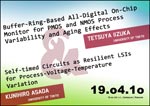
Tetsuya Iizuka |
Kunihiro Asada |
| Buffer-Ring-Based All-Digital On-Chip Monitor for PMOS and NMOS Process Variability and Aging Effects | Self-timed Circuits as Resilient LSIs for Process-Voltage-Temperature Variation |
|
The improvement of VLSI process technologies over the last twenty years enables the integration of a large number of
transistors on a single chip, and significantly improves the circuit performance. However, VLSI design and verification
processes have become more and more complex. Moreover, a smaller feature sizes degrade the tolerance to the PVT (Process,
Voltage, and Temperature) variabilities and the reliability concerns such as Negative Bias Instability (NBTI) and Channel
Hot Carrier (CHC) have become of critical importance to nanoscale transistors. |
The operation of synchronous circuits, as widely used today, is becoming increasingly unstable caused by PVT variation.
The conventional margin-based design approach pays a large overhead to guarantee the safe operation, especially for delay.
Recently, semi-self-timed approaches have been proposed to mitigate these problems, where the circuits have an error
recovery mechanism along with delay-fault detection/prediction circuits such as a double sampling of signals. These
approaches, however, still need a timing margin, in which the delay variation should be confined. |
|
Biography | Iizuka Tetsuya Iizuka received the B.S., M.S., and Ph.D. degrees in electronic engineering from the University of Tokyo, Tokyo, Japan, in 2002, 2004, and 2007, respectively. Then he worked as a high-speed serial interface circuit designer for two years. He joined University of Tokyo again in 2009, and is currently an Assistant Professor at the VLSI Design and Education Center, University of Tokyo. His research interests include digitally-assisted analog circuits and VLSI computer-aided-design. He is a member of the Institute of Electrical and Electronics Engineers (IEEE). |
Biography | Iizuka Kunihiro Asada received the B. S., M. S., and Ph.D. in electronic engineering from University of Tokyo in 1975, 1977, and 1980, respectively. In 1980 he joined the Faculty of Engineering, University of Tokyo, and became a lecturer, an associate professor and a professor in 1981, 1985 and 1995, respectively. From 1985 to 1986 he stayed in Edinburgh University as a visiting scholar supported by the British Council. From 1990 to 1992 he served as the first Editor of English version of IEICE (Institute of Electronics, Information and Communication Engineers of Japan) Transactions on Electronics. In 1996 he established VDEC (VLSI Design and Education Center) with his colleagues in University of Tokyo, which is a center to promote education and research of VLSI design in all the universities and colleges in Japan. He also served as the Chair of IEEE/SSCS Japan Chapter in 2001-2002 and the Chair of IEEE Japan Chapter Operation Committee in 2007-2008. He is currently in charge of the director of VDEC. His research interest is design and evaluation of integrated systems and component devices. He has published more than 400 technical papers in journals and conference proceedings. He has received best paper awards from IEEJ (Institute of Electrical Engineers of Japan), IEICE and ICMTS and so on. He is a member of IEEE, IEICE and IEEJ. |